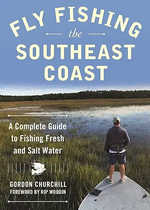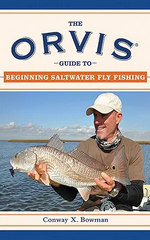- You can’t catch a fish without a hook in the water. Keep false casting to a minimum and go fishing.
- Never put a wet hook or fly back into the box with dry hooks or flies.
- Keep weights from bouncing against your rod.
- Always store a reel with the drag loose.
- Don’t use high pressure from a hose to rinse off reels.
- Put clear fingernail polish around the base of line guides to prevent rust and corrosion.
- Sound travels well under water so keep noise down when wading or in a boat.
- Drive into shallow water with the motor tilted all the way down. Don’t tilt the motor up until you have to raise it to get out of shallow water.
- Wet a knot before tightening it when using mono.
- Turn the bottom of the steering wheel the direction you want the trailer to go when backing.
- Learn to use your mirrors when backing a trailer.
- The longer the trailer, the easier it is to back.
- Front-wheel drive cars may need someone sitting on the hood to retrieve a boat up a steep ramp.
- Use safety chains and always cross them.
- Use a second chain or hook for the front of a boat when trailering.
- Check the heat of trailer hubs to make sure the bearings are greased.
- Wobbling tires indicate the bearings are shot- stop as soon as possible.
- Carry a bottle jack when trailering a boat.
- Always have a good spare tire for your trailer.
- Spot-weld the ball to the receiver and use a lock on the receiver bar.
- Never use a bow line longer than the boat so it cannot wrap the prop if it falls into the water.
- Don’t travel with rods sticking up in rod holders when trailering. A bird or branch or big insect can destroy them.
- Tip tops and glue are cheap- get a batch of various sizes for your tackle bag.
- Good electrical tape can repair a lot of things- a leaking hose, a busted reel seat, a line guide that comes loose, or a cut in your skin.
- Your throwable device (cushion) must be readily available in your boat.
- Wear a hat with a wide brim to keep sun off the tops of your ears and hooks out of your neck.
- Always carry an extra rod and reel.
- Rubber nets tend not to catch hooks.
- Rubber nets don’t take slime off a fish.
- Take a net larger than what you expect to catch.
- Use old bread pans to freeze ice blocks you can double-bag for your cooler.
- Fill large soda bottles close to full with water and freeze for some “re-usable ice.”
- Throw some saltwater in the cooler with ice to make the temperature lower than 32º F.
- A minnow that comes back “scaled” was in a flounder’s mouth.
- A blue fish will cut a minnow in two.
- If you get ½ a minnow back after a strike, throw it back out. The juices may attract a redfish.
- Otters can open most minnow buckets. Get a 5-gal. bucket with a top, drill holes in the top and sides and attach rope securely so you can throw if off the end of dock.
- Pogies need 1 gal. of water per fish in a livewell.
- Mud minnow and live shrimp can last several weeks in a bucket tied off on a dock.
- Florida is considered “home” for the ICW so keep red markers on your right as you head south on the ICW (“Red right returning”)
- Beware of inlets and rivers where red markers may be in places where green ICW markers should be.
- Don’t trust markers if water conditions (breaking waves, for instance) warn of danger.
- Always carry a whistle in your boat in case you horn doesn’t work.
- Take a small bucket in case your bilge pump doesn’t work.
- A 5-gal bucket is a cheap john.
- Turn your fire extinguishers (you do carry more than one, don’t you?) upside down several times if the powder is caked in the bottom.
- Check the nozzle on your fire extinguishers frequently for mud dauber nests.
- Always have cable ties in your fishing bag.
- Always carry a side cutter for hooks
- The official correct speed for No Wake Zones is idle speed (not always possible in heavy tides).
- Your wake is often far larger and more damaging at slow speed than at full speed.
- Shuffle your feet when wading in shallow water to avoid stepping on a sting ray.
- When you see lightning, start counting 1 Mississippi, 2 Mississippi… For each 6 seconds before hearing the thunder, the lightning is one mile away.
- In our area, snow usually comes off the ocean, not from the west.
- When fly fishing in the ocean, use sinking or intermediate line instead of floating line which will undulate with the wave action.
- When coming in an inlet on an incoming tide, ride the back side of a wave- keep your hand on the throttle.
- When going into large waves, power into them at an angle so you won’t be flipped. At the crest, turn back straight to avoid broaching. Turn at an angle again for the next wave, then turn straight at the crest.
- If you lose power offshore, tie a bucket to the bowline and throw it overboard. It will keep you heading into the waves.
- Never anchor from your stern- always from the bow.
- The hardest thing about fly fishing is remembering how easy it is.
- Always hold a fly rod loosely.
- On the back cast, say, I love living in North Carolina before starting the forward cast. It takes about that long for the back cast to unfold.
- When casting into the wind, try to cast as low as possible (side-arm) because the wind is slower near the surface.
- Don’t accelerate your back cast until the fly line is off the water and only the leader and fly are still in the water. Otherwise you will scare every fish in the vicinity.
- You are less likely to lose a fish if your drag is a bit too loose and you have to tighten it than if it is too tight and you have to loosen it.
- Select good knots that are easy to tie and them practice tying them a lot.
- Check your line and leaders before every trip.
- Clear your line frequently, even during the middle of a day of fishing, if you can hear it grating on your line guides.
- Don’t let a hooked fish rest.



